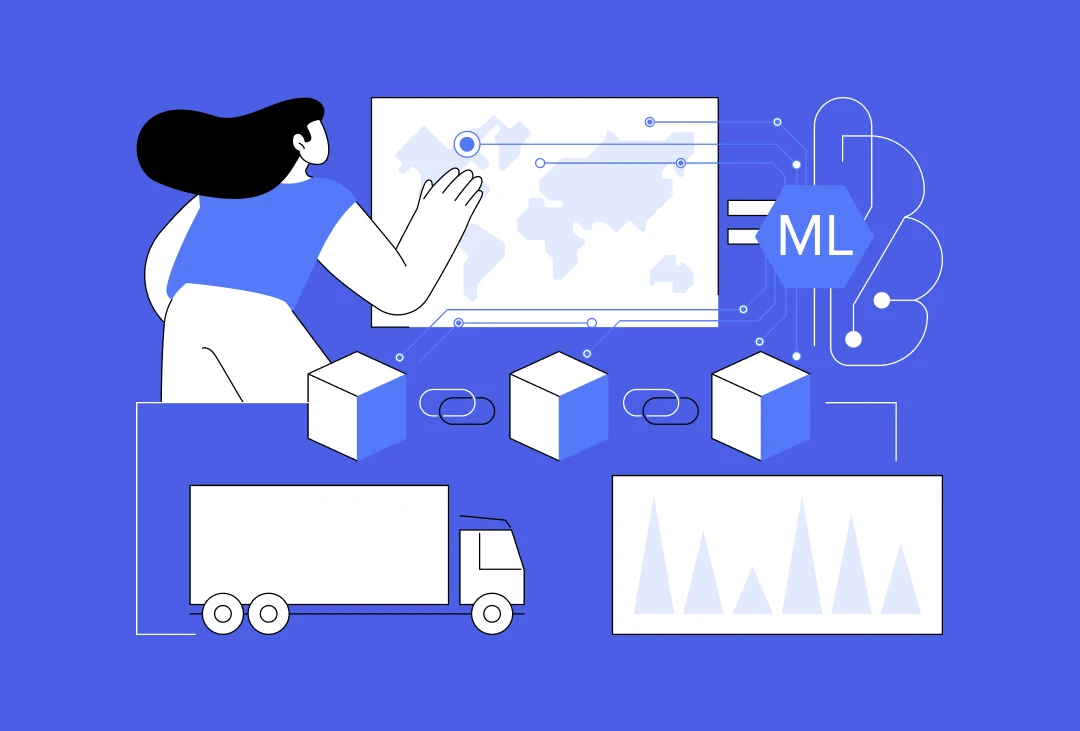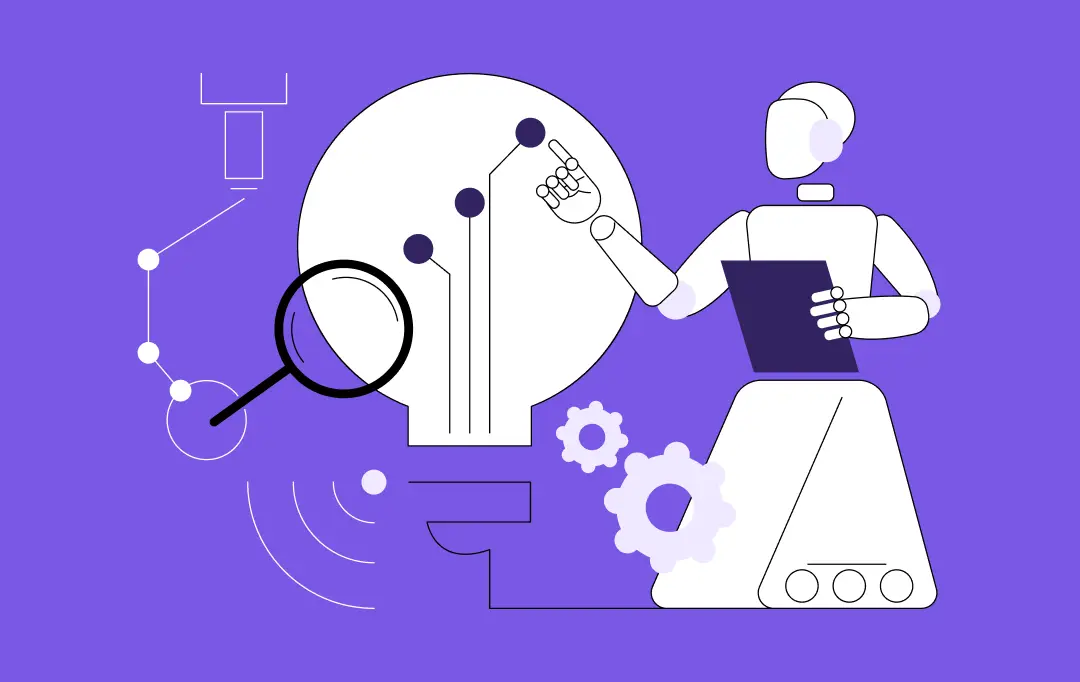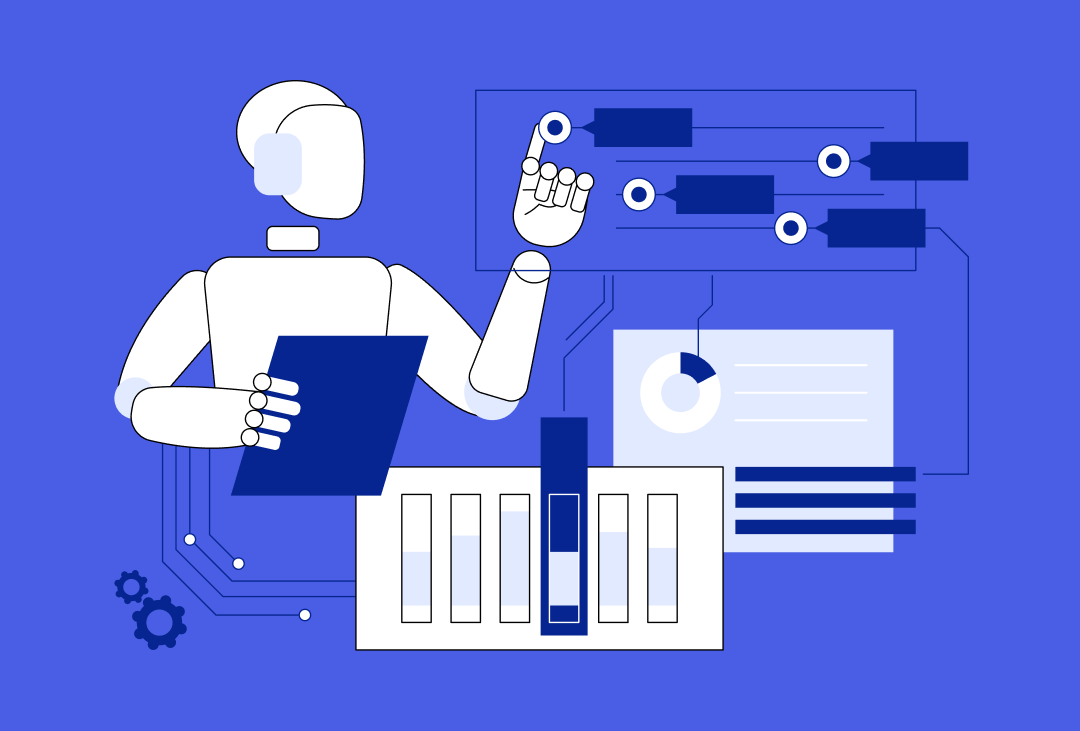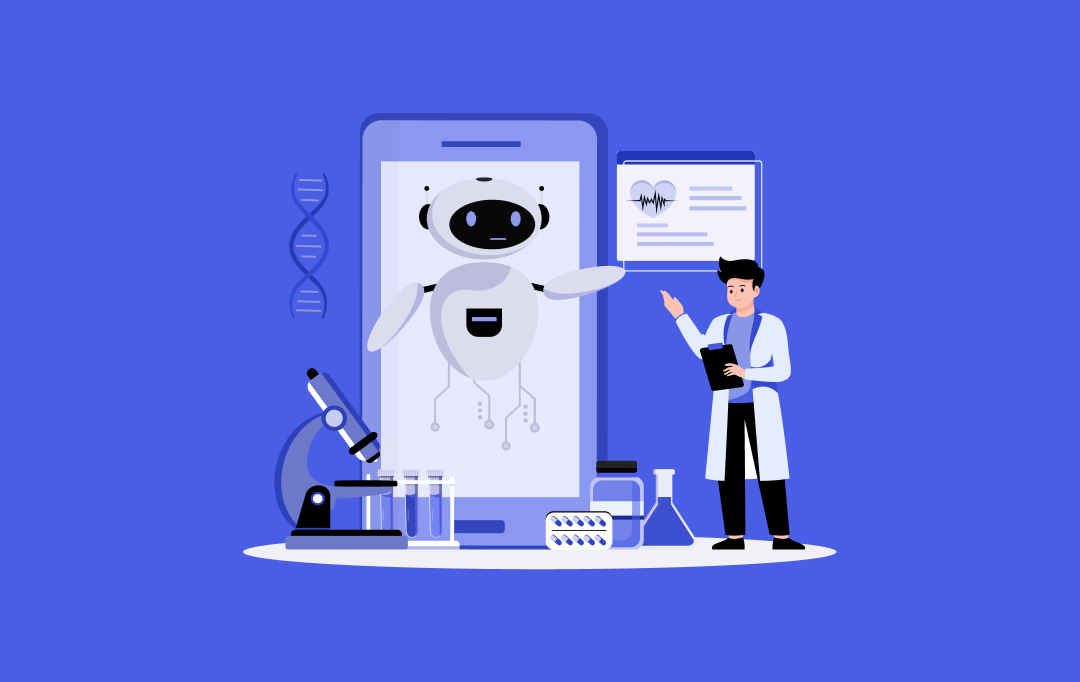AI agents are no longer science projects—they’re becoming everyday tools for people who want answers with minimal search efforts. Take Perplexity.ai, for instance. It doesn’t just pull data from the web; it curates it, summarizes it, and serves it in a conversational, intelligent, and incredibly useful way. For entrepreneurs, this isn’t just impressive—it’s a signal.
We’re entering an era where information is abundant but attention is scarce. Users don’t want to sift through ten search results anymore. They want context, clarity, and something that understands what they’re asking and responds with relevance. AI agents are stepping into that gap—and winning.
“Artificial intelligence would be the ultimate version of Google. The ultimate search engine that would understand everything on the web. It would understand exactly what you wanted, and it would give you the right thing. We’re nowhere near doing that now. However, we can get incrementally closer to that, and that is basically what we work on.”
By Larry Page, Co-Founder of Google
The growing interest to build an AI app like Perplexity proves that users are ready to embrace a new way of interacting with information. It’s leaner than a traditional search engine, smarter than a basic chatbot, and agile enough to fit into everything from education platforms and research tools to enterprise knowledge bases.
Here’s the opportunity: while big players are racing to dominate general-purpose AI, there’s still enormous white space in niche markets—think legal, medical, travel, finance, and even internal business operations. A custom-built AI agent tailored to a specific use case or audience can create serious value and differentiation.
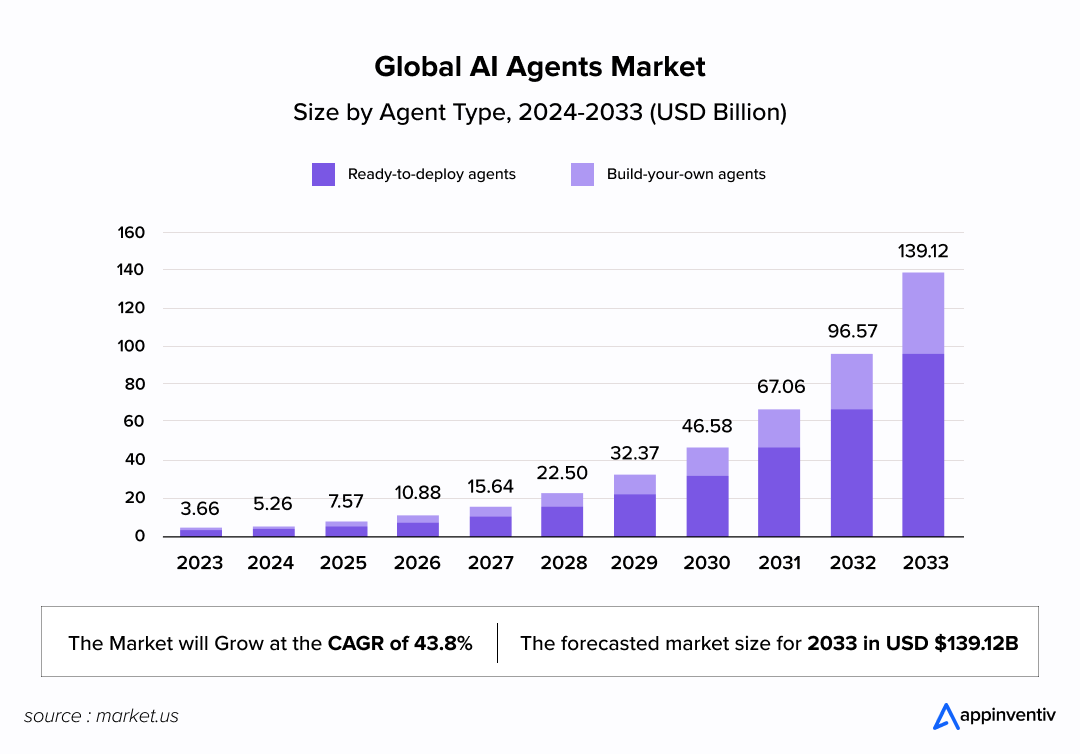
But before you jump in, there’s the inevitable question: How much will the Perplexity app cost?
The answer isn’t one-size-fits-all. It depends on how ambitious your roadmap is, what infrastructure you’re planning for, and how close you want to get to Perplexity-level capabilities.
To give a rough range, an AI App like Perplexity development can cost from $150,000 to over $1 million, depending on the complexity and scope of the project.
In this article, we’ll walk through the costs to make an AI app like Perplexity.ai – from the technology stack and talent requirements to budget ranges and smart trade-offs. If you’re considering investing in this space, this guide will help you make informed, strategic decisions from day one.
What is the Cost to Build an AI App like Perplexity?
The AI-based app development cost like Perplexity, can swing anywhere between $150,000 to over $1 million, depending on how deep you want to go with features, infrastructure, and model integration.
It’s not just about hiring developers and writing code,it’s about stitching together AI, UX, data pipelines, APIs, and performance architecture into something users genuinely enjoy using.
Here’s a rough breakdown of Perplexity app development cost based on complexity:
MVP-Level Cost to Build an AI Agent like Perplexity ($150,000 – $300,000):
Ideal for startups testing a niche use case.
- Uses pre-built LLM APIs (like OpenAI or Claude)
- Basic conversational UI with minimal personalization
- Search capability layered over a limited dataset or specific sources
- Advanced RAG (Retrieval-Augmented Generation)
- Limited analytics or admin tools
Great for proving product-market fit without burning cash upfront.
Mid-Tier Cost to Build an AI App like Perplexity ($300,000 – $600,000):
For entrepreneurs aiming for something more polished and scalable.
- Custom integration of Language Learning Models (LLMs) with retrieval systems
- Live search + citation features (like Perplexity does)
- User profiles, query history, and saved threads
- Analytics dashboard for usage insights
- A mix of open-source components and cloud infrastructure for flexibility
Balanced approach for long-term scaling and monetization.
Full-Scale Perplexity App Cost ($600,000 – $ 1 M+):
For those going all in to compete head-to-head or build an AI-first product.
- Custom LLM fine-tuning or proprietary model training
- Scalable RAG architecture with multi-source real-time crawling
- Personalization, deep context memory, and follow-up threads
- Voice/chat extensions, browser plugins, and mobile apps
- Security, AI regulations and compliance, and infrastructure to handle enterprise demand.
Now that we have examined the high-level estimates to develop an AI app like Perplexity, I am sure you must be wondering how we arrived at this range. Well, in the next section, we will examine the factors affecting AI app development cost like Perplexity in detail.
Factors Affecting AI App Development Cost Like Perplexity
If you are looking to build an AI tool like Perplexity, you must ponder important choices about the model and infrastructure. These decisions have a direct effect on aspects like latency, cost per user, customizability compliance, and the product plan. Here’s a quick breakdown of these factors and how they relate to expenses.
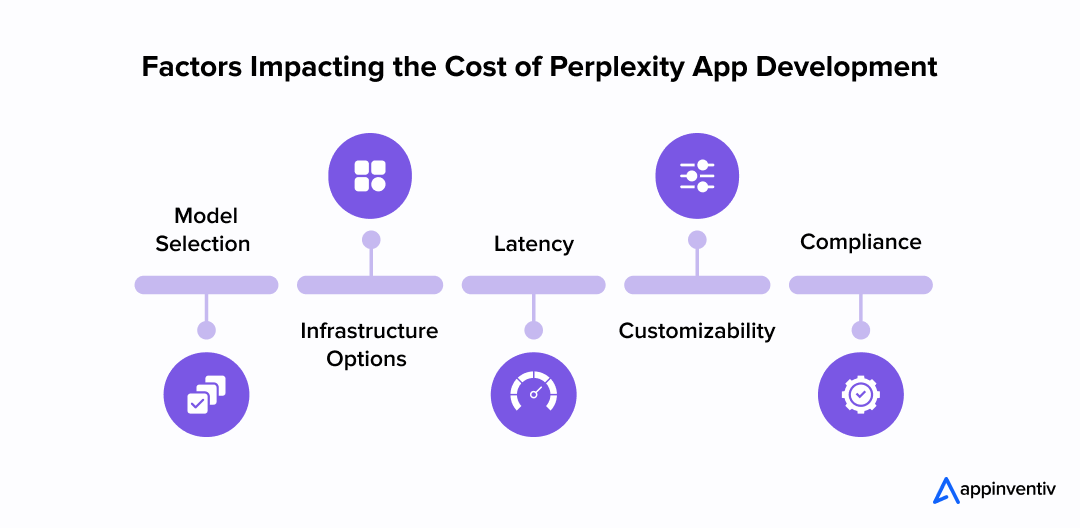
Model Selection
Deciding between large-scale language models, smaller niche models, or a mix of both changes how well the system works and what it costs. Bigger models give better results but have higher expenses and slower response times. Smaller models save money but are harder to adapt for specific needs. This also helps you preventing AI model collapse.
Impact: Advanced AI intelligent models need more computing power, which drives up infrastructure costs and causes delays. Concerns like data privacy might also limit which models can be used.
Infrastructure Options
Choosing between cloud services, on-premises setups, or combining both affects scalability and spending. AI in cloud computing let you adjust resources, but costs climb as usage grows. On-premises systems cost a lot upfront but provide more control over compliance.
Impact: Choices in infrastructure influence user costs and delays. Cloud expenses grow as more users join.
Latency Needs
Apps needing quick response times depend on advanced systems like GPUs or edge computing. This setup costs more. Apps that can afford delays use slower, cheaper options.
Impact: Focusing on low delays boosts user experience but raises building and running expenses.
Customizability
Apps offering more specific features, like special LLMs fine-tuning, require extra time, data, and talent, which increases costs. Simpler apps save money but provide less flexibility in competitive spaces.
Impact: Customization adds to the product development timeline and drives up expenses because it requires tailored engineering.
Compliance
Meeting regulations like GDPR compliance and HIPAA requires secure systems with encrypted data, and regular audits, which increase spending. Ignoring these rules can lead to fines and harm public trust.
Impact: Compliance adds to initial and recurring costs but is essential to gaining market entry and maintaining user confidence.
| Factors |
Impact on Cost |
Estimated Cost Range |
| Model Choice |
High (larger models = higher compute) |
$50,000–$500,000/year |
| Infrastructure |
High (cloud vs. on-premises) |
$20,000–$1M+/year |
| Latency |
Moderate (low latency = pricier hardware) |
$10,000–$200,000/year |
| Customizability |
Moderate to High (fine-tuning, data) |
$30,000–$300,000/year |
| Complaince |
Moderate (security, audits) |
$15,000–$150,000/year |
Note: Costs vary based on app scale, user base, and specific requirements. Figures are approximate for a mid-sized AI app.
It is crucial for you to balance these factors for cost-effective AI app development. Model and infrastructure decisions will impact the latency, cost per user, and compliance, while customizability and regulatory needs influence the product roadmap.
How to Lower These AI App Development Cost like Perplexity AI?
The cost to build an AI tool like Perplexity doesn’t have to start with a million-dollar runway. Here’s how smart entrepreneurs are keeping costs manageable while still creating value:
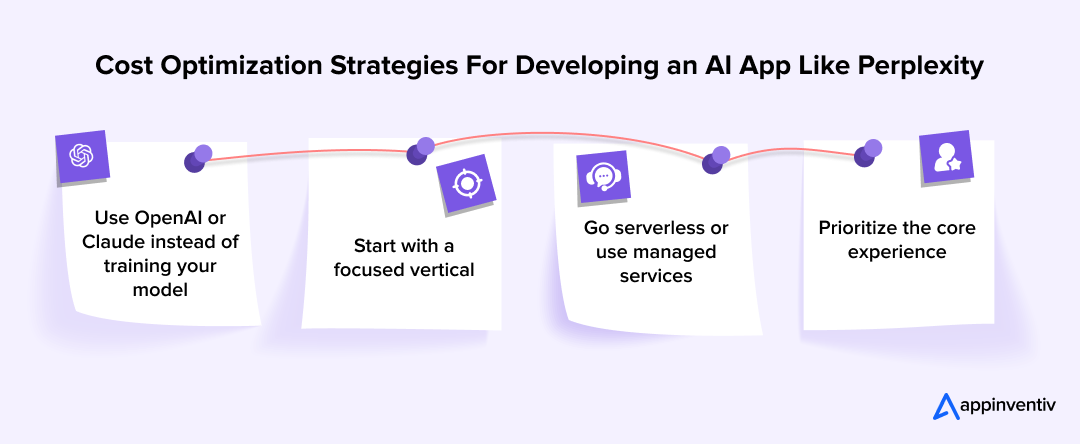
- Use OpenAI or Claude instead of training your model: You can switch to a custom model later when the product justifies it.
Bonus Read: Cost to Build a Text-to-Video Generator like OpenAI’s Sora
- Start with a focused vertical: Legal research, healthcare data, and internal company knowledge each lower your dataset and feature complexity.
- Leverage open-source libraries: LangChain, Haystack, LlamaIndex, and Weaviate can save you months of dev time.
- Go serverless or use managed services: Infrastructure costs add up quickly. Services like Vercel, Firebase, or AWS Lambda offer solid scalability for early-stage builds.
- Prioritize the core experience: You don’t need voice, browser extensions, and real-time search on Day 1. Nail the core use case first.
By making the right decisions when you make an AI app like Perplexity right from the start, you’re not just saving money, you’re buying speed, learning cycles, and flexibility to pivot as the market responds.
What are the Must-have Features of an AI app like Perplexity AI?
What makes Perplexity.ai more than “just another chatbot” is its fusion of search, AI, and UX into one seamless, utility-first product. The answer to how to develop an AI app like Perplexity has an impact beyond just cost. It sets the standard for user experience, marketability, and even the future of the product.
If you’re looking to build your own Perplexity AI, these are the cornerstone features that need to be part of your roadmap:
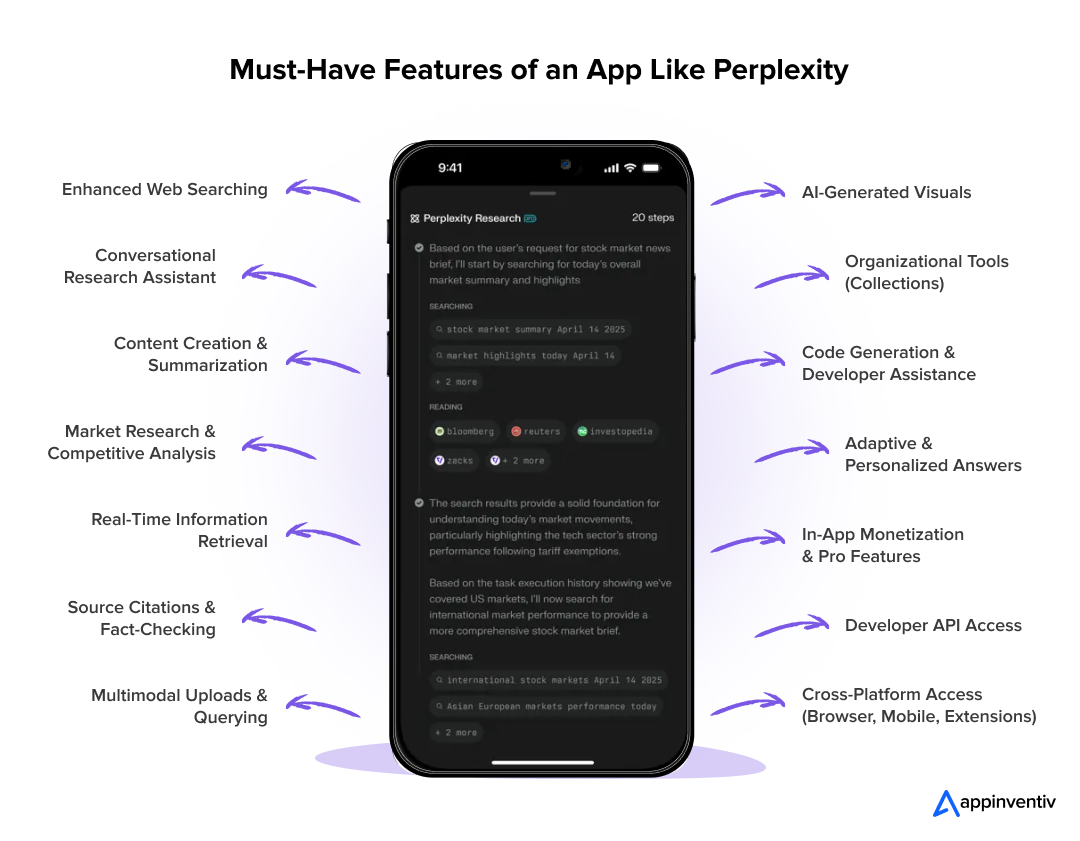
Enhanced Web Searching
Perplexity doesn’t rely on static training data, and it taps into the live internet. It crawls multiple sources in real time and synthesizes far more comprehensive answers than what you’d get from a traditional search engine. When you create an app like Perplexity AI, think of it as search, comprehension, and summarization rolled into one step.
Conversational Research Assistant
Follow-up questions, contextual memory, and dynamic dialogue make it feel less like a Q&A bot and more like an intelligent research partner. Build an AI tool like Perplexity to enable your users to ask a question, dig deeper, change directions, and keep up without losing context.
Content Creation & Summarization
Beyond answers, Perplexity is an AI content detection tool. It can generate structured articles, product summaries, SEO copy, and more. It also excels at digesting long-form content, books, whitepapers, or research, and presenting bite-sized insights without distortion.
Bonus Read: Cost of developing an AI content detection tool
Market Research & Competitive Analysis
Business users leverage Perplexity Pro to scan the web for trends, financials, product comparisons, and consumer insights. It’s not just about gathering information; it’s about structuring it clearly and backed by citations.
Real-Time Information Retrieval
Need the latest news, sports scores, or a stock update? Your app similar to Perplexity AI can access current sources instead of relying on outdated training cutoffs, making it truly responsive to the moment.
Source Citations & Fact-Checking
Each output includes linked references – something most AI tools overlook. When you make an AI agent like Perplexity, this simple functionality can boost user trust and makes the platform suitable for serious research or content validation.
Multimodal Uploads & Querying
There are various applications of Multimodal AI, one among them is that it enables users to upload images, PDFs, and even large documents, and the Perplexity AI feature will interpret them to answer questions or generate content. This bridges the gap between static file storage and dynamic information extraction.
AI-Generated Visuals
The Pro version of an app similar to Perplexity AI should include image generation based on prompts, which is especially useful for marketers, educators, and creatives looking to visualize ideas on the fly.
Organizational Tools (Collections)
Collections let users save and sort conversations by theme – ideal for ongoing research, project tracking, or sharing knowledge with teams. It transforms the chat interface into a lightweight knowledge management tool.
Code Generation & Developer Assistance
For technical users, this Perplexity AI feature can provide functional code snippets, explain logic, or help troubleshoot. It’s not a full IDE replacement, but it saves time and context switching for quick tasks.
Adaptive & Personalized Answers
Perplexity adjusts answers based on user prompts, changing tone, format, or purpose (like casual vs. academic). This adaptability makes it feel custom-built for each user, something to note when you get to develop an AI agent like Perplexity.
In-App Monetization & Pro Features
Perplexity’s freemium model includes a smooth in-app upgrade path, unlocking faster responses, deeper search, image support, and more. This revenue layer, part of Perplexity AI features, makes it more than just a product—it’s a business engine.
Bonus Read: Insider’s Strategies to Make Money From Apps
Developer API Access
While not a MVP level answer to how to build an AI tool like Perplexity, entrepreneurs and enterprises can integrate Perplexity’s intelligence into their own tools or platforms using its Pro API, unlocking white-labeled or embedded AI experiences.
Cross-Platform Access (Browser, Mobile, Extensions)
From Chrome extensions to mobile apps, Perplexity is designed to be wherever users are researching, ensuring continuity and increasing daily usage frequency.
These features of an AI app like Perplexity AI contributes to why some AI agents feel “smart,” useful, and different from generic LLM wrappers. When mapping out your version, it’s not about checking every box, but choosing the right ones that align with your users and use case.
The Experience Side of an App Like Perplexity
You could have the smartest AI agent under the hood, but people will bounce if the user interface feels clunky or confusing. Fast. Perplexity.ai’s appeal doesn’t lie in just what it knows, but how effortlessly delivers that knowledge. Clean layout. Seamless chat flow. Instant follow-up. Thoughtful citations. It all adds up.
If you’re looking to develop an AI app like Perplexity, here are the UX elements that can’t be afterthoughts:
- Fast, Chat-Like Flow
The core interaction needs to feel natural, like texting a genius friend who just happens to know everything. That means clean design, minimal friction, and speed.
Bonus Read: The Timeless List of UX Deliverables
- Citations and Expandable Sources
Trust is everything in AI. Giving users clear references (with clickable links) builds transparency and makes your tool feel more reliable than generic chatbots.
- Follow-Up Prompts
Don’t just answer the question; help users explore it further. Smart suggestions like “Want to explore this further?” or “Related insights” keep them engaged.
- Saved Threads or Collections
Power users must organize their queries, revisit old conversations, or export research. Features like “Collections” and “History” go a long way here.
- Responsive Across Devices
Whether someone is on a desktop during a deep work session or on mobile mid-commute, the experience should adapt without hiccups.
- Tone & Personalization
Some people want detailed answers, while others want quick summaries. Giving users control over how they receive answers adds a new layer of value.
- Searchable Memory
If you’re offering persistent threads, memory, or knowledge continuity, make it intuitive to recall what was said before.
This UX layer, when you build your own Perplexity AI, isn’t a sidekick to the AI; it’s the stage where your product performs. And it’s often what separates a technical demo from a tool users keep returning to.
How Technical Decisions Impact the Development Costs?
One of the biggest costs of building an AI app Perplexity levers and technical decisions you’ll face when building an AI agent like Perplexity are choosing what model to use and where it’ll run. This part isn’t just backend plumbing. It shapes performance, user experience, speed, cost per interaction, and long-term scalability.
Let’s break it down.
Off-the-Shelf APIs (OpenAI, Anthropic, Cohere, etc.)
This is the quickest way to get your product into the world. You plug into someone else’s infrastructure, pay per token, and skip the headache of hosting, training, or scaling models.
Pros:
- Fastest time-to-market
- No model maintenance
- Battle-tested reliability and language quality
Cons:
- Usage-based billing can get expensive at scale
- You’re locked into someone else’s roadmap, pricing, and guardrails
- Limited customization
Ideal for MVPs, early testing, or small teams.
Open-Source or Fine-Tuned Models (LLaMA, Mistral, Falcon, etc.)
Here, you are self-hosting or working with a provider to run and tune your models. That means more freedom, but also more complexity.
Pros:
- Lower long-term costs if you expect high volume
- Full control over safety settings, output behavior, and domain-specific tuning
- You can fine-tune for niche use cases (e.g., legal, medical, finance)
Cons:
- High upfront infra and engineering investment
- Need for ongoing monitoring, versioning, and patching
- Risk of slower response times if the infrastructure isn’t optimized
This route is best suited for companies with an experienced artificial intelligence development company partnership or specific needs that mainstream APIs can’t meet.
Hosting Choices: Cloud vs. Self-Hosted GPUs
Where you run your model also matters.
- Cloud inference (AWS, Azure, GCP) offers flexibility, autoscaling, and ease of integration, but it comes at a price.
- Self-hosted GPU infrastructure (on-prem or collocated) is cost-effective for massive scale, but requires DevOps muscle and careful planning.
- Some teams also go hybrid: API-based for general queries, self-hosted for domain-specific prompts.
So don’t treat this as a backend detail; it’s one of your most strategic choices.
The Hidden Infrastructure That Adds Up Fast
Once your AI agent starts working beyond basic chat, the real architectural demands kick in, and so does the AI app development cost like Perplexity AI. Let’s break down four backend pillars that quietly (but significantly) affect your total cost of development and ownership:
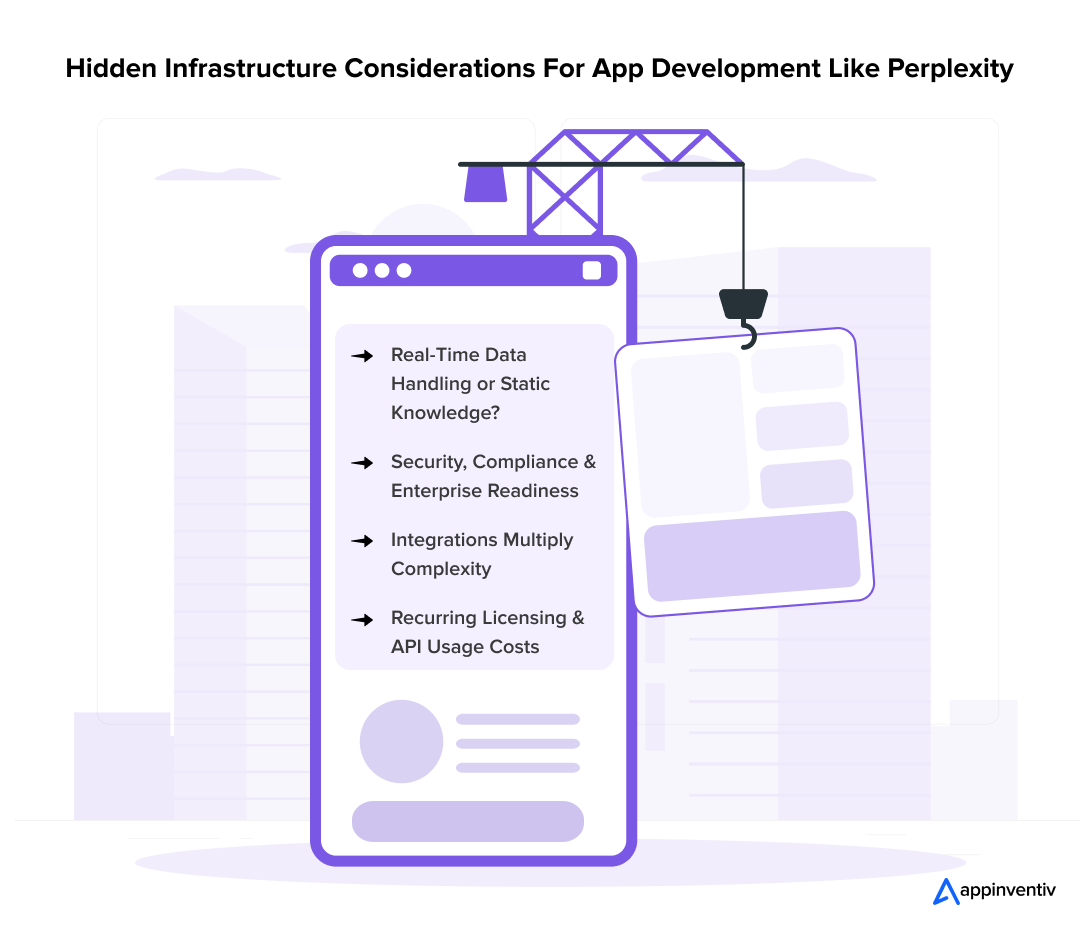
Real-Time Data Handling or Static Knowledge?
Do you want to create an app like Perplexity AI that answers using a pre-trained knowledge base, or do you want it to search the web, pull live feeds, or index new content in real time?
Real-time functionality means:
- Web scraping pipelines
- Caching layers
- Browser automation
- API polling logic
This setup doesn’t just add development time but also the maintenance overhead and compliance risks (depending on what you’re pulling from and how fast).
Security, Compliance & Enterprise Readiness
If you’re building for enterprises, B2B clients, or any regulated industry, you’re stepping into the world of:
- SOC 2, HIPAA, and GDPR readiness
- Secure data storage and access controls
- Role-based permissions, audit trails, encryption
These aren’t optional if you’re handling sensitive or proprietary data, and they can stretch your dev cycles and AI based app development cost like Perplexity significantly.
Integrations Multiply Complexity
Want your agent to fetch CRM data, update records, or personalize outputs based on third-party apps? Every integration, whether internal (like your analytics stack) or external (news APIs, weather feeds, stock tickers), adds:
- Authentication flows
- Error handling
- Rate limit management
- Testing and version compatibility work
Great for end-user experience. But it needs thoughtful planning upfront.
Recurring Licensing & API Usage Costs
Even if you go the plug-and-play route with OpenAI, Claude, or Gemini, remember:
- Every query costs tokens
- Long prompts or multiple replies per session can get expensive fast
- Costs compound as usage grows
Many startups launch on API-based models and switch to open-source once they hit volume. Planning for that transition early can save you thousands in Perplexity app development cost.
“What Perplexity is, today, is what Larry Page wanted Google to be, 23 years ago. But the timing wasn’t right back then. There were no chat LLMs. But the man was a visionary. The ultimate search engine is an AI-powered answer engine, like Perplexity.”
By Aravind Srinivas, CEO of Perplexity AI
What is the Stage-by-stage Process to Build an AI Tool like Perplexity
The efforts to make an AI agent like Perplexity aren’t a sprint; it’s a layered process. Each stage has its timelines, cost implications, and decision bottlenecks. Here’s what the journey to develop an AI agent like Perplexity typically looks like:
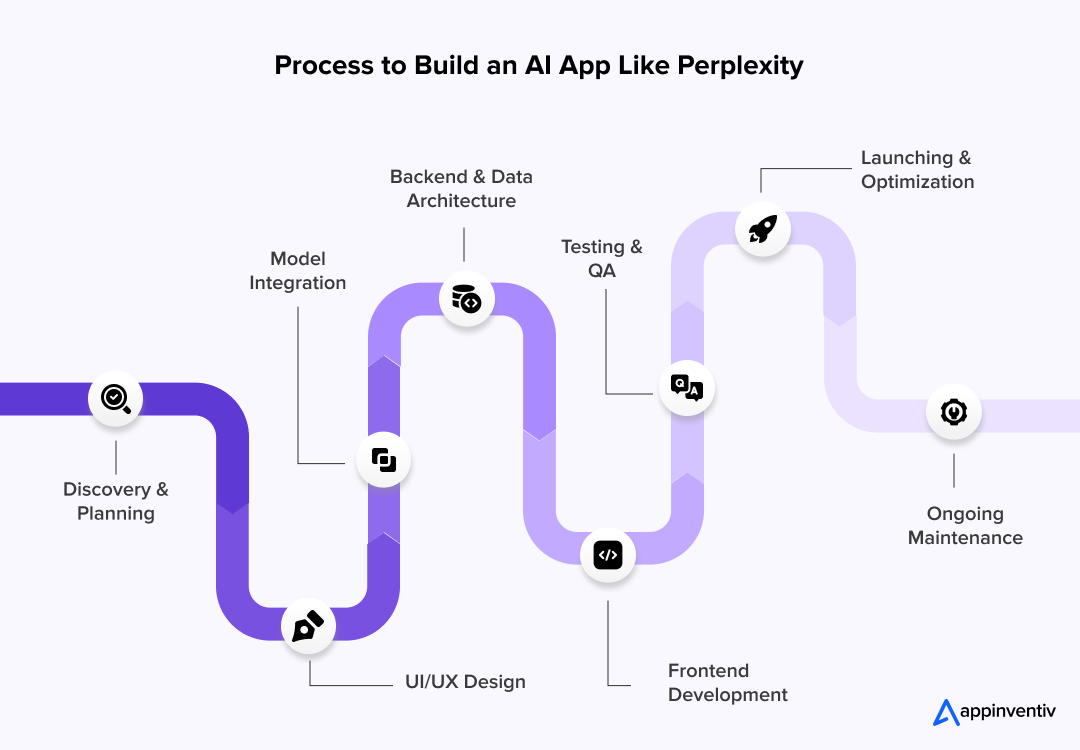
Discovery & Planning
This is where ideas turn into architecture. You’ll map core features, define user flows, assess technical feasibility, and choose between using OpenAI or going open-source.
Estimated cost: $5K–$15K
This depends on how much upfront R&D, technical scoping, and UI/UX ideation are needed.
UI/UX Design
Whether it’s a sleek search interface, interactive threads, or minimal input-output windows, design sets the tone for usability. Think: mockups, wireframes, and prototyping.
Estimated cost: $8K–$20K
Higher for agents with advanced interactivity, personalization layers, or mobile-first designs.
Model Integration
This is where the brain gets wired in. Using OpenAI’s API is quicker to ship. Going with LLaMA or Mistral, you’ll need more dev time for fine-tuning, hosting, and evaluations.
Estimated cost to build an AI tool like Perplexity:
- Off-the-shelf model integration: $10K–$25K
- Fine-tuning or open-source LLMs: $30K–$80K
Backend & Data Architecture
Think infrastructure, APIs, database design, real-time logic, logging, user authentication, and data pipelines. This phase is where reliability and scale are baked in.
Estimated cost to build an AI agent like Perplexity: $15K–$40K
Costs grow with complexity, especially if you’re handling live data or caching external sources like Perplexity.
Frontend Development
The agent’s interface meets the user here. Depending on the platform (web, mobile, or both), you’ll build dynamic components, input handlers, and integration views.
Estimated cost: $10K–$25K
Includes responsiveness, accessibility, and performance tuning.
Testing & QA
AI agents don’t just break; they behave unexpectedly. This phase covers functionality testing, edge cases, prompt handling, integration tests, and UX/UI validation.
Estimated cost: $5K–$12K
It could spike if your product has heavy integrations or multi-device support.
Launch & Optimization
You’re alive, but that doesn’t mean it’s done. In this phase, expect fixes, minor feature additions, token consumption tuning, and user feedback loops.
Estimated cost: $3K–$10K (initial), plus monthly optimization budgets if scaling
Ongoing Maintenance
APIs change, models improve, and users want more. Keep a buffer for updates, versioning, cost optimization, and incident response.
Estimated monthly spend: $2K–$10K
Depends on usage, infrastructure setup, and how fast you plan to iterate.
What Pushes Your AI Agent’s Cost Up?
The cost to build an AI app like Perplexity you can expect, others sneak in. These are the common culprits that inflate the budget, often without warning:
- Overengineering Early On: It’s tempting to launch with every bell and whistle. But going too complex too fast – like adding advanced personalization, multi-modal inputs, or enterprise-level compliance – can spike dev hours and infrastructure needs. Pro Tip: Start lean, then scale.
- Real-Time Data Access: Want your agent to fetch live news, stock prices, or sports scores? Cool, but it adds scraping logic, caching systems, and potentially premium API usage, all of which add both dev complexity and runtime Perplexity app cost.
- Unclear Feature Scope: When the product vision shifts mid-build (it usually does), you risk redoing workflows, interfaces, and backend logic. This leads to extra sprints, and extra spend in the cost of building an AI app Perplexity. Pro Tip: Lock your MVP scope early. Evolve after feedback, not during build.
- Custom Model Training or Fine-Tuning: Want to teach the AI your unique domain language? That’s powerful, but fine-tuning involves dataset prep, model evaluation, retraining, and often experimentation.
- Expensive Token Usage: Third-party models like GPT-4 or Claude often charge per token. If your users are heavy, expect the monthly AI app development cost, like Perplexity AI to balloon, especially if your app uses multiple prompts, memory threads, or web-connected lookups per session.
- Heavy Integration Needs: Plugging into tools like CRMs, analytics dashboards, or internal APIs sounds great until your devs spend weeks wrangling auth issues, error handling, and updates to unstable endpoints.
- Security, Compliance & Enterprise Readiness: If your users are in healthcare, finance, or enterprise, expect to invest in things like SOC 2 audits, role-based access controls, encrypted data stores, and incident management pipelines.
- Lack of Iteration Budget: Even after launch, user feedback will pour in. Not budgeting for quick-turnaround updates or scaling changes can bottleneck growth, or worse, break trust and skyrocket the AI-based app development cost like Perplexity.
How Appinventiv Can Help You Build Smarter, Faster AI Solutions
Being a globally recognized artificial intelligence development company, we at Appinventiv understand that the efforts to build an AI app like Perplexity should be more than just a tech project; it’s a strategic business move. Entrepreneurs come to us not just for code, but for clarity, guidance, and outcomes. That’s why we approach every project as a custom-built AI solution designed to fit your exact market needs, timeline, and budget.
Whether you start with a rough idea or refine a working prototype, we help you define a clear roadmap, prioritize the right features for version one, and get to market quickly with a functional MVP.
Our teams are deeply experienced in working with leading LLMs like OpenAI, Claude, and Mistral. Still, we’re just as comfortable helping you choose an open-source model or designing your fine-tuning pipeline when the use case calls for it.
Our ability to connect the dots—from user experience to infrastructure, data flow, and long-term scalability—sets us apart. We help you make the right architectural choices early on, right from when you develop an AI app like Perplexity, to avoid surprises later.
And unlike many dev shops, we don’t disappear after launch. We stay on to help you refine, iterate, and grow – whether that means scaling your cloud environment, optimizing model costs, or adding features based on user behavior.
We would love to be your tech partner if you’re looking to build reliable, future-ready AI solutions that can deliver value, not just cool demos. All you need to do is contact us and share your business vision; the rest, leave everything to us.
FAQs
Q. How do I build an AI app like Perplexity?
A. Define the core use case – research assistant, conversational search, or knowledge summarizer. Next, choose the right large language model (GPT-4, Claude, or an open-source LLaMA variant). From there, the answer on how to make an AI app like Perplexity will need developers to build the UX, set up infrastructure, integrate APIs, manage real-time data handling, and ensure compliance. Working with a seasoned AI development partner can streamline this entire journey.
Q. How much does it cost to develop an AI agent like Perplexity?
A. Ai agent development cost like Perplexity can range from $100K to $ 500 K+, depending on feature complexity, model choice, infrastructure, integrations, and whether you’re going with off-the-shelf APIs or fine-tuned custom models. You can reduce the early-stage Perplexity app cost by launching a focused MVP and using hosted models before scaling up.
Q. Can I use ChatGPT or Claude directly instead of training my model?
A. Absolutely, and many do. Off-the-shelf models like GPT-4 or Claude are great for faster, cheaper development. However, fine-tuning or using open-source models can be a better long-term option if you need more control over data, behavior, or costs at scale.
Q. What infrastructure do I need for an AI app like this?
A. You’ll need cloud infrastructure to host your backend, manage API calls, and (optionally) support GPU-based inference if using custom models. Your choices here – cloud vs. self-hosted, managed APIs vs. raw model hosting – can significantly impact performance and cost.
Q. How long does it take to build an AI agent like Perplexity?
A. A functional MVP with basic chat and search abilities can take 3–4 months. A fully-featured product with real-time search, citations, integrations, and fine-tuning can stretch to 6–9 months, depending on team size and product vision.
Q. Do I need real-time web access for my AI app to work well?
A. Not necessarily. A curated static knowledge base might be enough if your app is domain-specific. But if your use case demands current events, live data, or dynamic user queries, you’ll need systems for real-time crawling, scraping, or API fetching.
Q. What are the ongoing costs after launch?
A. Expect recurring expenses for model/API usage (like OpenAI tokens), cloud hosting, updates, monitoring, and user support. If your user base grows, the cost of building an AI app Perplexity, can scale quickly – planning for that early is key.
Q. How can I keep development costs under control?
A. Start with a lean MVP focused on core value. Use managed APIs to reduce infrastructure overhead. Choose a partner who can validate your scope and suggest where to save without sacrificing user experience. Prioritize scalability, but don’t build everything at once.
IT Managed & Outsourcing
Didn't find what you're looking for? Let us know your needs, and we'll tailor a solution just for you.



